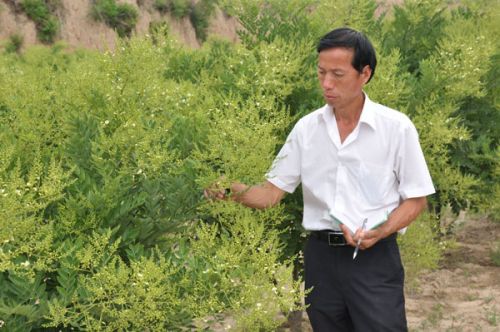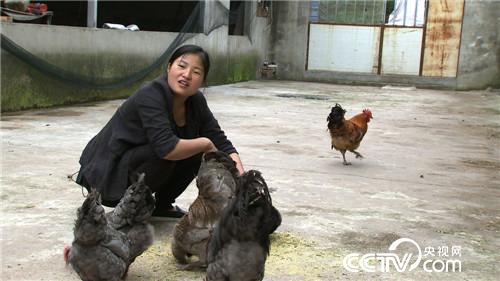A record of 20 years' hard excavation of the Road to Wealth and the Development of double-season Huai Industry in Lei Maoduan

On May 24, Wang Rulin, secretary of Shanxi Provincial Party Committee, specially pointed out the double-season locust tree at the teleconference on poverty alleviation work in Shanxi Province. What is Double Season? Why does it make a provincial party committee secretary value it so much?
Landmark contribution from more than 20 years of hard work
Goudong Village is located in the northernmost part of Yuncheng Salt Lake District in Shanxi Province. In the north is Jiwang Mountain and in the east is Huoyan Mountain. The land is on the mountains. There is no water at all. One mu of wheat can only hit more than 100 catties. Life is a problem. In 1980, electricity had been received in Goudong Village, but almost half of the families were still using oil lamps because they could not afford electricity.
In order to change this situation, in 1981, Lei Maoduan quit his job as a private teacher and contracted more than 100 mu of land in the village, planting apples, pears and hawthorn trees. Unexpectedly, these fruit trees did not bear fruit because of drought and a large number of deaths, Lei Maoduan lost a lot of money. However, this failure made Lei Maoduan understand a truth: the masses of dry wall must find new economic trees to become rich.
After searching hard, Lei Maoduan accidentally discovered the locust tree that "stands upright on the cliff, does not change for a hundred years, is not afraid of drought, and is not afraid of root rot." He also carefully analyzed the sales situation of Sophora japonica, found that Sophora japonica prices are always high, and in medicine, chemicals, health care and other aspects have a unique role. If we can turn the sophora japonica used for ecological greening into a sophora japonica special for bearing sophora japonica, it will definitely become a very good economic tree species in the dry wall area. Lei Maoduan suddenly thought: cultivate a new variety of sophora japonica and walk out of an innovative road of dry wall agriculture!
Lei Maoduan is determined to turn this dream into reality and fill the gap that no one in domestic scientific research institutes has studied.
First of all, he investigated and studied a large number of varieties of Sophora japonica all over the country, collected more than 700 kinds of seeds and 1500 kinds of scions from more than 200 areas from Shanxi, Hebei, Henan, Guangdong and Guangxi, grafted and planted in his more than 50 mu experimental garden respectively. He studied the theory of artificial hybridization carefully and repeated all kinds of experiments. However, three years have passed, five years have passed, and one experiment after another has ended in failure. He was in the throes of desperation.
Lei Maoduan really wanted to give up this research that might never succeed. However, when he really wanted to give up, he looked at the barren hills of his hometown and remembered the oath he had made at the beginning. He decided to endure all the pain and try his best to persevere.
Hard work pays off. After more than 20 years of efforts, in 1999, a unique new variety of dry wall crops-Shuangjihuai was finally born. Double-season locust tree can harvest sophora flower twice a year, produce fruit in two years, produce high yield in three years and produce high yield in five years. It is not afraid of drought or barren. In hilly and dry areas, the income per mu is 6,000 or 7,000 yuan, and the average benefit per mu is dozens or even hundreds of times that of traditional crops. In April 2012, it passed the identification of scientific and technological achievements by Science and Technology Department of Shanxi Province; in May of that year, it passed the "Examination and Approval of Improved Tree Varieties" by Forest Variety Examination and Approval Committee of Shanxi Province. On August 13, 2013, the Forestry Department of Shanxi Province held a symposium on the development of double-season locust in Yuncheng City. The leaders and experts attending the symposium unanimously believed that "double-season locust solved the social problem of low economy in the dry area and filled the domestic gap. It was a milestone in the history of forestry development in Shanxi and even China. Lei Maoduan's contribution was huge and historic."
On May 24, Wang Rulin, secretary of Shanxi Provincial Party Committee, specially pointed out the double-season locust tree at the teleconference on poverty alleviation work in Shanxi Province. What is Double Season? Why does it make a provincial party committee secretary value it so much?
Landmark contribution from more than 20 years of hard work
Goudong Village is located in the northernmost part of Yuncheng Salt Lake District in Shanxi Province. In the north is Jiwang Mountain and in the east is Huoyan Mountain. The land is on the mountains. There is no water at all. One mu of wheat can only hit more than 100 catties. Life is a problem. In 1980, electricity had been received in Goudong Village, but almost half of the families were still using oil lamps because they could not afford electricity.
In order to change this situation, in 1981, Lei Maoduan quit his job as a private teacher and contracted more than 100 mu of land in the village, planting apples, pears and hawthorn trees. Unexpectedly, these fruit trees did not bear fruit because of drought and a large number of deaths, Lei Maoduan lost a lot of money. However, this failure made Lei Maoduan understand a truth: the masses of dry wall must find new economic trees to become rich.
After searching hard, Lei Maoduan accidentally discovered the locust tree that "stands upright on the cliff, does not change for a hundred years, is not afraid of drought, and is not afraid of root rot." He also carefully analyzed the sales situation of Sophora japonica, found that Sophora japonica prices are always high, and in medicine, chemicals, health care and other aspects have a unique role. If we can turn the sophora japonica used for ecological greening into a sophora japonica special for bearing sophora japonica, it will definitely become a very good economic tree species in the dry wall area. Lei Maoduan suddenly thought: cultivate a new variety of sophora japonica and walk out of an innovative road of dry wall agriculture!
Lei Maoduan is determined to turn this dream into reality and fill the gap that no one in domestic scientific research institutes has studied.
First of all, he investigated and studied a large number of varieties of Sophora japonica all over the country, collected more than 700 kinds of seeds and 1500 kinds of scions from more than 200 areas from Shanxi, Hebei, Henan, Guangdong and Guangxi, grafted and planted in his more than 50 mu experimental garden respectively. He studied the theory of artificial hybridization carefully and repeated all kinds of experiments. However, three years have passed, five years have passed, and one experiment after another has ended in failure. He was in the throes of desperation.
Lei Maoduan really wanted to give up this research that might never succeed. However, when he really wanted to give up, he looked at the barren hills of his hometown and remembered the oath he had made at the beginning. He decided to endure all the pain and try his best to persevere.
Hard work pays off. After more than 20 years of efforts, in 1999, a unique new variety of dry wall crops-Shuangjihuai was finally born. Double-season locust tree can harvest sophora flower twice a year, produce fruit in two years, produce high yield in three years and produce high yield in five years. It is not afraid of drought or barren. In hilly and dry areas, the income per mu is 6,000 or 7,000 yuan, and the average benefit per mu is dozens or even hundreds of times that of traditional crops. In April 2012, it passed the identification of scientific and technological achievements by Science and Technology Department of Shanxi Province; in May of that year, it passed the "Examination and Approval of Improved Tree Varieties" by Forest Variety Examination and Approval Committee of Shanxi Province. On August 13, 2013, the Forestry Department of Shanxi Province held a symposium on the development of double-season locust in Yuncheng City. The leaders and experts attending the symposium unanimously believed that "double-season locust solved the social problem of low economy in the dry area and filled the domestic gap. It was a milestone in the history of forestry development in Shanxi and even China. Lei Maoduan's contribution was huge and historic."
- Prev

Xu Xiaolan: her daughter started a business to regain her father's confidence.
Xu Xiaolan: her daughter started a business to regain her father's confidence.
- Next

Mountain complex of an entrepreneurial female college student in Taoxi Town, Wuping County
Mountain complex of an entrepreneurial female college student in Taoxi Town, Wuping County
Related
- A course of planting techniques and methods on how to grow carrots
- How to plant the latest tulips?
- Is it better to pick tea in the morning or in the afternoon? When is the best time for tea to be picked? what is the third or fifth tea?
- Launch Yuanxiao Happy combination Haocha + Tea Yuan healthy Taste
- Penghu Tourism "Fireworks 20 Parade with You"
- 2022 West Lake Happiness holds "Digital Revitalization Voucher" and draws iphone13 and laptop.
- Banqiao Fuzhou social houses are designed to change start-up combined with police elimination to create a safe and livable environment
- The convenient measure of "mechanical weeding" in Xinbei has been abused and the Agriculture Bureau has imposed heavy penalties on the illegal land consolidation.
- Changgeng University Joins Hands with Four Memory Factories to Rescue Memory Talent Shortage
- The list of Taiwan's top 100 MVP managers is listed by the Director-General of the Farmers' Association of Sanxia District.

